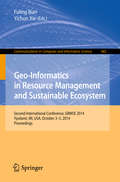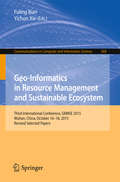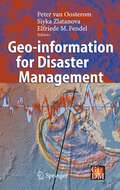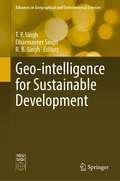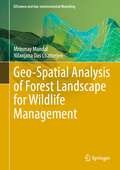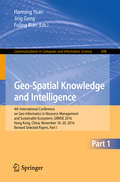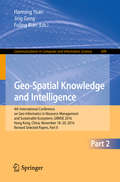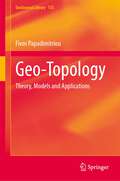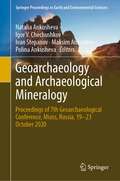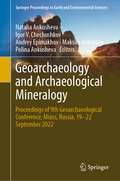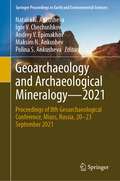- Table View
- List View
Geo-Informatics in Resource Management and Sustainable Ecosystem: International Conference, GRMSE 2014, Ypsilanti, USA, October 3-5, 2014, Proceedings (Communications in Computer and Information Science #482)
by Fuling Bian Yichun XieThis volume constitutes the refereed proceedings of the Second International Conference on Geo-Informatics in Resource Management and Sustainable Ecosystem, GRMSE 2014, held in Ypsilanti, MI, China, in December 2014. The 73 papers presented were carefully reviewed and selected from 296 submissions. The papers are divided into topical sections on smart city in resource management and sustainable ecosystem; spatial data acquisition through RS and GIS in resource management and sustainable ecosystem; ecological and environmental data processing and management; advanced geospatial model and analysis for understanding ecological and environmental process; applications of geo-informatics in resource management and sustainable ecosystem.
Geo-Informatics in Resource Management and Sustainable Ecosystem: Third International Conference, GRMSE 2015, Wuhan, China, October 16-18, 2015, Revised Selected Papers (Communications in Computer and Information Science #569)
by Fuling Bian Yichun XieThis volume constitutes the refereed proceedings of the Third International Conference on Geo-Informatics in Resource Management and Sustainable Ecosystem, GRMSE 2015, held in Wuhan, China, in October 2015.The 101 papers presented were carefully reviewed and selected from 321 submissions. The papers are divided into topical sections on Smart City in Resource Management and Sustainable Ecosystem; Spatial Data Acquisition Through RS and GIS in Resource Management and Sustainable Ecosystem; Ecological and Environmental Data Processing and Management; Advanced Geospatial Model and Analysis for Understanding Ecological and Environmental Process; Applications of Geo-Informatics in Resource Management and Sustainable Ecosystem.
Geo-information: Technologies, Applications and the Environment (Geotechnologies and the Environment #5)
by Mathias LemmensGeomatics, the handling and processing of information and data about the Earth, is one geoscience discipline that has seen major changes in the last decade, as mapping and observation systems become ever more sensitive and sophisticated. This book is a unique and in-depth survey of the field, which has a central role to play in tackling a host of environmental issues faced by society. Covering all three strands of geomatics - applications, information technology and surveying - the chapters cover the history and background of the subject, the technology employed both to collect and disseminate data, and the varied applications to which geomatics can be put, including urban planning, assessment of biodiversity, disaster management and land administration. Relevant professionals, as well as students in a variety of disciplines such as geography and surveying, will find this book required reading. This rapidly developing field uses increasingly complex and accurate systems. Today, technology enables us to capture geo-data in full 3D as well as to disseminate it via the Web at the speed of light. We are able to continuously image the world from space at resolutions of up to 50 cm. Airborne LiDAR (laser surveying) sensors can be combined with digital camera technology to produce geometrically correct images of the Earth's surface, while integrating these with large-scale topographic maps and terrestrial as well as aerial images to produce 3D cityscapes that computer users can explore from their desktops.
Geo-information for Disaster Management
by Peter Van Oosterom Siyka Zlatanova Elfriede FendelGeo-information technology can be of considerable use in disaster management, but with considerable challenge in integrating systems, interoperability and reliability. This book provides a broad overview of geo-information technology, software, systems needed, currently used and to be developed for disaster management. The text invites discussion on systems and requirements for use of geo-information under time and stress constraints and unfamiliar situations, environments and circumstances.
Geo-Informationssysteme: Ein Studien- und Arbeitsbuch
by W. LinderDer Titel bietet in seiner Kombination aus Text, Software und Übungsbeispielen eine ideale Grundlage für das (Selbst)studium. Er richtet sich insbesondere an Studierende der Geographie, Geodäsie, Kartographie, Geoinformatik, Raumplanung und benachbarter Fachgebiete. In einem ersten Teil werden die theoretischen Grundlagen räumlicher Daten und ihrer Verarbeitung behandelt um dem Leser z.B. Entscheidungen hinsichtlich der zu verarbeitenden Informationen (Umfang, Auflösung etc.) zu ermöglichen und Hilfestellung bei der Beurteilung erzielter Ergebnisse zu geben. Der zweite Teil umfasst ein Tutorial mit dessen Hilfe der Leser anhand der mitgelieferten Software und Datensätze verschiedene Aspekte räumlicher Informationsverarbeitung in einzelnen Projekten nachvollziehen kann.
Geo-intelligence for Sustainable Development (Advances in Geographical and Environmental Sciences)
by T. P. Singh Dharmaveer Singh R. B. SinghGlobally, concerns for the environment and human well-being have increased as results of threats imposed by climate change and disasters, environmental degradation, pollution of natural resources, water scarcity and proliferation of slums. Finding appropriate solutions to these threats and challenges is not simple, as these are generally complex and require state-of-the-art technology to collect, measure, handle and analyse large volumes of varying data sets. However, the recent advances in sensor technology, coupled with the rapid development of computational power, have greatly enhanced our abilities to capture, store and analyse the surrounding physical environment. This book explores diverse dimensions of geo-intelligence (GI) technology in developing a computing framework for location-based, data-integrating earth observation and predictive modelling to address these issues at all levels and scales. The book provides insight into the applications of GI technology in several fields of spatial and social sciences and attempts to bridge the gap between them.
Geo-Platinum 87
by H. M. Prichard Philip J. PottsThe Geo-Platinum 87 Symposium, held at the Open University during April 1987, was designed as a forum for presentation of new research results on the occurrence, genesis, geochemistry, mineralogy and analysis of the platinum-group elements (PGE). With the support of the Open University and the Mineral Industry Research Organisation, the symposium was attended by 115 representatives of university departments, research institutions and members of the mining and mineral exploration industries. An introduction to the symposium was provided by two invited papers from C. J. Morrissey (Riofinex North) and C. R. N. Clark (Johnson Matthey) which were designed to give perspective to the goals of PGE research work. The first of these papers gave a provocative insight into the aims and objectives of an exploration manager, examining the influence of supply, demand and perceived world reserves on exploration strategy. The second invited paper gave a valuable view of the industrial uses, market trends and predicted changes in the commercial value of the platinum-group elements from the standpoint of a refining company and supplier. These invited papers are reproduced in this volume and are followed by twenty four full papers and twenty abstracts that reflect the wide range of research topics presented at the symposium.
Geo-societal Narratives: Contextualising geosciences
by Martin Bohle Eduardo MaroneThis book provides an accessible overview of the societal relevance of contemporary geosciences. Engaging various disciplines from humanities and social sciences, the book offers philosophical, cultural, economic, and geoscientific insights into how to contextualise geosciences in the node of Culture and Nature.The authors introduce two perspectives of societal geosciences, both informed by the lens of geoethics. Throughout the text core themes are explored; human agency, the integrity of place, geo-centricity, economy and climate justice, subjective sense-making and spirituality, nationalism, participatory empowerment and leadership in times of anthropogenic global change. The book concludes with a discussion on culture, education, or philosophy of science as aggregating concepts of seemingly disjunct narratives.The diverse intellectual homes of the authors offer a rich resource in terms of how they perceive human agency within the Earth system. Two geoscientific perspectives and fourteen narratives from various cultural, social and political viewpoints contextualise geosciences in the World(s) of the Anthropocene.
Geo-Spatial Analysis of Forest Landscape for Wildlife Management (GIScience and Geo-environmental Modelling)
by Mrinmay Mandal Nilanjana Das ChatterjeeThis book presents research on landscape ecology and the relationship between humans and wildlife. It helps readers understand how ecological patterns and processes are interconnected. This research illustrates and proposes (practicable) management strategies toward long-term ecological restoration and mitigation of consequences of conflict. Increasing wildlife activities in localities and forest fringes are an alarming issue. Ecological processes like movement, colonization, extinction and conflict issues depend on the landscape and ecological activities, the movement for example of migratory elephants and their colonization not only affects society but the wildlife and biodiversity too. Strategic management measures can contribute to enriching the biodiversity, habitat quality as well as landscape, while minimizing human-wildlife conflicts. This book describes landscape ecological patterns and processes, habitat dominancy, habitat dependency, suitability, connectivity and corridor selection. To synthesize these patterns and processes, several ecological indices are used. Use of geo-spatial techniques improves future management strategies for similar circumstances, especially, related to forest regeneration and forest restoration. This book provides a concise overview to a wide range of readers including postgraduate students, researcher, academics, landscape planners, decision makers and even local populations. The techniques and management strategies described should help planners to improve forest management, by implementing quality enhancement programs such as plantation area selection and corridor selection.
Geo-Spatial Knowledge and Intelligence: 4th International Conference on Geo-Informatics in Resource Management and Sustainable Ecosystem, GRMSE 2016, Hong Kong, China, November 18-20, 2016, Revised Selected Papers, Part I (Communications in Computer and Information Science #698)
by Hanning Yuan Jing Geng Fuling BianThe two volume proceedings of CCIS 698 and 699 constitutes revised selected papers from the 4th International Conference on Geo-Informatics in Resource Management and Sustainable Ecosystem, GRMSE 2016, held in Hong Kong, China, in November 2016. The total of 118 papers presented in these proceedings were carefully reviewed and selected from 311 submissions. The contributions were organized in topical sections named: smart city in resource management and sustainable ecosystem; spatial data acquisition through RS and GIS in resource management and sustainable ecosystem; ecological and environmental data processing and management; advanced geospatial model and analysis for understanding ecological and environmental processes; applications of geo-informatics in resource management and sustainable ecosystem.
Geo-Spatial Knowledge and Intelligence: 4th International Conference on Geo-Informatics in Resource Management and Sustainable Ecosystem, GRMSE 2016, Hong Kong, China, November 18-20, 2016, Revised Selected Papers, Part II (Communications in Computer and Information Science #699)
by Hanning Yuan Jing Geng Fuling BianThe two volume proceedings of CCIS 698 and 699 constitutes revised selected papers from the 4th International Conference on Geo-Informatics in Resource Management and Sustainable Ecosystem, GRMSE 2016, held in Hong Kong, China, in November 2016. The total of 118 papers presented in these proceedings were carefully reviewed and selected from 311 submissions. The contributions were organized in topical sections named: smart city in resource management and sustainable ecosystem; spatial data acquisition through RS and GIS in resource management and sustainable ecosystem; ecological and environmental data processing and management; advanced geospatial model and analysis for understanding ecological and environmental processes; applications of geo-informatics in resource management and sustainable ecosystem.
Geo-Spatial Technologies in Urban Environments: Policy, Practice, and Pixels
by Ryan R. Jensen Jay D. Gatrell Daniel McLeanThis book expands the current frame of reference of remote sensing and geographic information specialists to include an array of socio-economic and related planning issues. Using remotely sensed data, the project explores the efficacy and policy implications of new approaches toward analyzing data, integrates approaches from human geography and explores the utility of employing geo-technologies to further the politics of local growth and smart growth coalitions, as in green space programs.
Geo-Spatial Technologies in Urban Environments: Policy, Practice, and Pixels
by Ryan R. Jensen Jay D. Gatrell Daniel McLeanThis book demonstrates the application of remote-sensing data and geographic information systems to the exploration of issues often ignored by the mainstream community of geo-technical specialists such as urban forestry, urban traffic, migration or quality of life in urban areas. Case studies show how environmental science and planning, sociology, landscape ecology and architecture can benefit from employing remote-sensing data and GIS.
Geo-Sustainnovation for Resilient Society: Select Proceedings of CREST 2023 (Lecture Notes in Civil Engineering #446)
by Hemanta Hazarika Stuart Kenneth Haigh Babloo Chaudhary Masanori Murai Suman ManandharThis book presents select proceedings of the 2nd International Conference on Construction Resources for Environmentally Sustainable Technologies (CREST 2023), and focuses on sustainability, promotion of new ideas and innovations in design, construction and maintenance of geotechnical structures with the aim of contributing towards climate change adaptation and disaster resiliency to meet the UN Sustainable Development Goals (SDGs). It presents latest research, information, technological advancement, practical challenges encountered, and solutions adopted in the field of geotechnical engineering for sustainable infrastructure towards climate change adaptation. This volume will be of interest to those in academia and industry alike.
Geo-Topology: Theory, Models and Applications (GeoJournal Library #133)
by Fivos PapadimitriouGeo-Topology is an exploration of the depth and breadth of the relationships between Geography and Topology, with applications ranging from Landscape Geography to Social Geography and from Spatial Analysis to Geospatial Technologies. It shows how topics of geographical research (landscapes, borders, spatial social relationships etc) can be examined by using mathematical concepts and methods of Topology, exposing the realm of geo-topological modelling and visualization through Point-Set Topology, Knot Theory, Reeb graphs, Topological Surfaces (i.e. Möbius bands and Klein bottles), Differential Topology, Network Analysis, Combinatorial Topology, Braid Theory and Ultrametric Topology. Besides geographers, this book is a trove of new ideas for landscape ecologists, mathematicians, data scientists, sociologists, psychologists, anthropologists and educators. Geo-Topology is a systematic introduction to topological thinking in Geography, also by highlighting the significance of Topology for Geographical Education, as well as for the Philosophy and Epistemology of Geography.
Geo-trekking in Ethiopia’s Tropical Mountains: The Dogu’a Tembien District (GeoGuide)
by Jan Nyssen Miro Jacob Amaury FranklThis book is based on over 150 scientific papers about the Dogu’a Tembien district in Ethiopia. To reach a broader public of people interested in geosites and human-environment interactions, the authors here add a geoguide about this mountain district in Ethiopia(13°30’ N, 39°10’ E; upto 2850 m high) which shows a varied lithology. A large team has carried out research in that district over the past 23 years, including long stays in the areas. Numerous viewpoints and geosites are only accessible on foot; hence the authors prepared the book as a trekking guide, which will enhance sustainable tourism in the same time. This edited work summarises the study results in the international literature into a comprehensive book, which comprises 35 thematic chapters, detailed description of 573 km of trekking routes to access the landscape and the most scenic excursion points, as well as the necessary logistical information. A state-of-the-art trekking map is included as a digital annex.
Geoarchaeology: The Human-Environmental Approach (Environmental History And Global Change Ser. #Vol. 8)
by Carlos CordovaGeoarchaeology is traditionally concerned with reconstructing the environmental aspects of past societies using the methods of the earth sciences. The field has been steadily enriched by scholars from a diversity of disciplines and much has happened as the importance of global perspectives on environmental change has emerged. Carlos Cordova, provides a fully up-to-date account of geoarchaeology that reflects the important changes that have occurred in the past four decades. Innovative features include: the development of the human-ecological approach and the impact of technology on this approach; how the diversity of disciplines contributes to archaeological questions; frontiers of archaeology in the deep past, particularly the Anthropocene; the geoarchaeology of the contemporary past; the emerging field of ethno-geoarchaeology; the role of geoarchaeology in global environmental crises and climate change.
Geoarchaeology and Archaeological Mineralogy: Proceedings of 7th Geoarchaeological Conference, Miass, Russia, 19–23 October 2020 (Springer Proceedings in Earth and Environmental Sciences)
by Natalia Ankusheva Maksim Ankushev Igor V. Chechushkov Ivan Stepanov Polina AnkushevaThis book of Springer Proceedings in Geoarchaeology and Archaeological Mineralogy contains selected papers presented at the 7th Geoarchaeology Conference, which took place during October 19–23, 2020, at the South Urals Federal Research Center, Ural Branch of Russian Academy of Sciences, Miass, Russia. The Proceedings combine studies in archeometry, geoarchaeology, and ancient North Eurasian technologies, including paleometallurgy, stone tools investigation, past exploitation of geological resources, bioarchaeology, residue analysis, pottery, and lithics studies. This book also specializes in various non-organic materials, rocks, minerals, ores, and metals, especially copper and metallurgical slags. Many types of research also use modern analytical methods of isotopic, chemical, and mineralogical analysis to address the composition and structure of ancient materials and the technological practices of past human populations of modern Russia, Ukraine, Turkmenistan, Tajikistan, and Mongolia. This book is intended for archaeologists, historians, museum workers, and geologists, as well as students, researchers from other disciplines, and the general public interested in the interdisciplinary research in the field of archaeology and archaeological materials, strategies and techniques of past quarrying, mining, metallurgy and lithic technologies at different chronological periods in Eurasian steppe and adjacent forest zone.
Geoarchaeology and Archaeological Mineralogy: Proceedings of 9th Geoarchaeological Conference, Miass, Russia, 19–22 September 2022 (Springer Proceedings in Earth and Environmental Sciences)
by Natalia Ankusheva Igor V. Chechushkov Andrey Epimakhov Maksim Ankushev Polina AnkushevaThe volume of Springer Proceedings in Geoarchaeology and Archaeological Mineralogy contains selected papers presented at the 9th Geoarchaeology Conference, which took place during September 19–22, 2022, at the South Urals Federal Research Center, the Ural Branch of the Russian Academy of Sciences, Miass, Russia. The Proceedings unite studies in the fields of archeometry, geoarchaeology, and ancient technologies, based on cases from northern Eurasia, and include archaeometallurgy, stone tools investigation, exploitation of geological resources in the past, bioarchaeology, residue analysis, pottery and lithics investigation, use of the GIS in archaeology. A study of non-organic materials, rocks, minerals, ores, metals, metallurgical slags is a special focus of the book. Many papers also use modern analytical methods of isotopic, chemical, and mineralogical analysis to study the composition and structure of ancient materials and the technological practices of past human populations of Modern Russia, Ukraine, Turkmenistan, Tajikistan, and Mongolia. The volume is intended for archaeologists, historians, museum workers, and geologists, as well as students, researchers from other disciplines, and the general public interested in the interdisciplinary research in the field of archaeology and archaeological materials, strategies and techniques of past quarrying, mining, metallurgy and lithic technologies at different chronological periods in Eurasian steppe and adjacent forest zone.
Geoarchaeology and Archaeological Mineralogy: Proceedings of 6th Geoarchaeological Conference, Miass, Russia, 16–19 September 2019 (Springer Proceedings in Earth and Environmental Sciences)
by Anatoly Yuminov Natalia Ankusheva Maksim Ankushev Elizaveta Zaykova Dmitry ArtemyevThis book presents general problems in geoarchaeology, and discusses geophysical solutions, X-ray fluorescence spectrometry applications, X-ray and isotope analyses and GIS technologies. It also examines practical reconstructions of technological processes used in ancient time, and investigates the use of minerals and rocks by ancient societies in the territories of modern Russia, Ukraine, Turkmenistan, and Tajikistan, as well as the characteristics of ores, metallurgical slags and data on the composition and impurities of archaeological metals. Intended for archaeologists, historians, museum workers and geologists studying noble metals and copper, the book is also a useful resource for students, graduate students, experts and anyone interested in the use of various minerals at different stages of humanity’s development.
Geoarchaeology and Archaeological Mineralogy—2021: Proceedings of 8th Geoarchaeological Conference, Miass, Russia, 20–23 September 2021 (Springer Proceedings in Earth and Environmental Sciences)
by Natalia N. Ankusheva Igor V. Chechushkov Andrey V. Epimakhov Maksim N. Ankushev Polina S. AnkushevaThis book unites studies in the fields of archaeometry, geoarchaeology, and ancient technologies, based on cases from northern Eurasia, and includes archaeometallurgy, stone tools investigation, exploitation of geological resources in the past, bioarchaeology, residue analysis, pottery and lithics investigation, and use of the GIS in archaeology. The book of Springer Proceedings in Geoarchaeology and Archaeological Mineralogy contains selected papers presented at the 8th Geoarchaeology Conference, which took place during September 20–23, 2021, at the South Urals Federal Research Center, the Ural Branch of the Russian Academy of Sciences, Miass, Russia. A study of non-organic materials, rocks, minerals, ores, metals and metallurgical slags is a special focus of the book. Many papers also use modern analytical methods of isotopic, chemical, and mineralogical analysis to study the composition and structure of ancient materials and the technological practices of past human populations of Modern Russia, Ukraine, Turkmenistan, Tajikistan and Mongolia. The book is intended for archaeologists, historians, museum workers and geologists, as well as students, researchers from other disciplines and the general public interested in the interdisciplinary research in the field of archaeology and archaeological materials, strategies and techniques of past quarrying, mining, metallurgy and lithic technologies at different chronological periods in Eurasian steppe and adjacent forest zone.
Geoarchäologie
by Christian Stolz Christopher E. MillerDas erste deutschsprachige Lehrbuch der Geoarchäologie bietet einen hervorragenden Einstieg in eine vielfältige Disziplin, die der Archäologie wie auch der Physischen Geographie und anderen Geowissenschaften zugewandt ist. Der Überblick über die breite methodische Vielfalt der Geoarchäologie macht dieses Buch zum verlässlichen Nachschlagewerk für Studierende, Forschende und Praktiker. Es gehört daher zum unverzichtbaren Handwerkszeug für alle, die sich mit umwelt- und kulturgeschichtlichen Fragen auseinandersetzen. Geoarchäologische Fragestellungen zählen zu den populärsten Themen innerhalb der beteiligten Fächer. Durch die Entschlüsselung von Geoarchiven mithilfe moderner Datierungs- und Analysemethoden und interdisziplinären Ansätzen gelingt es, frühere Kulturen innerhalb ihrer Umwelt zu verorten und vergangene Landschaften zu rekonstruieren. Gerade im Zeitalter des globalen Wandels erscheint es umso wichtiger, Zustände, Prozesse und Dynamiken der Vergangenheit zu verstehen, nicht zuletzt um daraus gewonnene Erkenntnisse auf zukünftige Entwicklungen anwenden zu können. Das Buch wurde von Wissenschaftlerinnen und Wissenschaftlern von über 30 verschiedenen Universitätsinstituten, Behörden und Forschungseinrichtungen erarbeitet. Die Herausgeber sind Sprecher des 2004 gegründeten Arbeitskreises Geoarchäologie. Ihre über 70 Mitautorinnen und Mitautoren gehören zu den kundigsten Fachleuten ihrer Themen im deutschsprachigen Raum und darüber hinaus.
Geobiology: Microbial Mats in Sandy Deposits from the Archean Era to Today
by Nora NoffkeA murmur is heard from the depths of time. Life and Earth are engaged in a dialog that has lasted for four billion years. Sometimes it’s a whisper, sometimes a roar. One part sometimes gets the upper hand, dominates the discussion and sets the agenda. But mostly the two have some kind of mutual understanding, and the murmur goes on. Most of us don’t listen. Nora does. She listens, and she tries to understand. Nora Noffke has focused her scientific career on the interaction between the living and the non-living. This is no mean task in an academic world where you are usually either this or that, such as either a biologist or a geologist. The amount of stuff you need to grasp is so large that it usually feels better to sit comfortably on one chair, rather than to risk falling between them. Geobiology is not for the faint of heart. Nora’s focus is on that all-important biological substance mucus, or EPS (ext- cellular polymeric substance). EPS is the oil in the machinery, the freeway to travel for many small animals and protists, the coat of armour for others, the mortar in the brick wall for yet others. For microbes such as cyanobacteria it may be the world they built, the world they live, eat, fight, multiply, and die in.
The Geobiology and Ecology of Metasequoia (Topics in Geobiology #22)
by Ben A. LePage Christopher J. Williams Hong YangThe plant fossil record indicates that the genus Metasequoia was widely distributed throughout the Northern Hemisphere from the early Late Cretaceous to the Plio-Pleistocene. Today the genus has shrunk to one species with approximately 5,000 mature individuals in southeastern China’s Xiahoe Valley. This book distills the current understanding of the biology, ecology and physiology of fossil and living Metasequoia, current research directions and problems that remain unresolved.
Geobiotechnological Solutions to Anthropogenic Disturbances: A Caribbean Perspective (Environmental Earth Sciences)
by Mark Anglin HarrisThis book offers a problem-and-solution approach to environmental remediation in mining, including the environmentally sustainable utilization of waste materials from the mining industry. It largely comprises articles published in Springer journals, which have been thoroughly revised and expanded. With supplementary data and illustrations, it discusses specific problem areas in relevant Caribbean locations and provides an overview of geotechnical and microbial solutions to prevent post-mining deterioration in this area.
